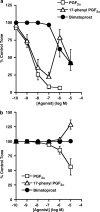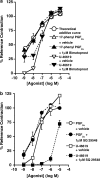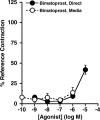Studies using isolated uterine and other preparations show bimatoprost and prostanoid FP agonists have different activity profiles
- PMID: 15678094
- PMCID: PMC1576027
- DOI: 10.1038/sj.bjp.0706044
Studies using isolated uterine and other preparations show bimatoprost and prostanoid FP agonists have different activity profiles
Abstract
1. The pharmacology of bimatoprost, a synthetic prostaglandin-amide, was examined in prostaglandin F(2alpha) (PGF(2alpha))-sensitive preparations. Bimatoprost potently contracted the rabbit isolated uterus (pEC(50)=7.92+/-0.16). In contrast, bimatoprost exhibited weak excitatory activity in human myometrium from pregnant and nonpregnant donors, mouse uterus, rat uterus, and endothelium-intact rabbit jugular veins, and did not stimulate DNA synthesis in mouse fibroblasts. 2. The possibility that the effects of bimatoprost may reflect partial agonism at prostanoid FP receptors was examined and the contractile effects of full agonists, 17-phenyl PGF(2alpha) (FP) and U-46619 (TP, a control), were determined in the absence and presence of 1 muM bimatoprost on the mouse uterus. Analyses of the agonist-agonist functional studies showed no antagonism, indicating that bimatoprost is not a partial agonist. 3. Bioassay metabolism studies of bimatoprost and latanoprost (FP receptor agonist prodrug) in the rabbit uterus were conducted using recipient mouse uterus. Results indicated that the potent responses to bimatoprost in the rabbit uterus are produced by the intact molecule and not by its putative free acid metabolite, 17-phenyl PGF(2alpha). Some hydrolysis of latanoprost to latanoprost free acid appears to have occurred in the rabbit uterus, according to biological detection. 4. The pharmacology of bimatoprost could not be explained by its interaction with known prostanoid FP receptors and was independent of species-, tissue-, or preparation-related factors. The potent contractile effects of bimatoprost in the rabbit uterus provide further pharmacological evidence for the presence of a novel receptor population that preferentially recognises bimatoprost.
Figures







References
-
- ARIËNS E.J., SIMONIS A.M., VAN ROSSUM J.M.Drug–receptor interaction: interaction of one or more drugs with one receptor system Molecular Pharmacology: The Mode of Action of Biologically Active Compounds 1964New York, London: Academic Press Inc; 119–286.vol 1. ed. Ariëns, E.J. pp
-
- BASU S., SJÖQUIST B., STJERNSCHANTZ J., RESUL B. Corneal permeability to and ocular metabolism of phenyl substituted prostaglandin esters in vitro. Prostagland. Leukotr. Essent. Fatty Acids. 1994;50:161–168. - PubMed
-
- BURTON K. Determination of DNA concentration with diphenylamine. Methods Enzymol. 1979;23:163–166.
-
- CHEN J., WOODWARD D.F., YUAN Y.-D., MARSHALL K., SENIOR J. Prostanoid-induced contraction of the rabbit isolated uterus is mediated by FP receptors. Prostaglandins Other Lipid Mediat. 1998;55:387–394. - PubMed
MeSH terms
Substances
LinkOut - more resources
Full Text Sources
Other Literature Sources

